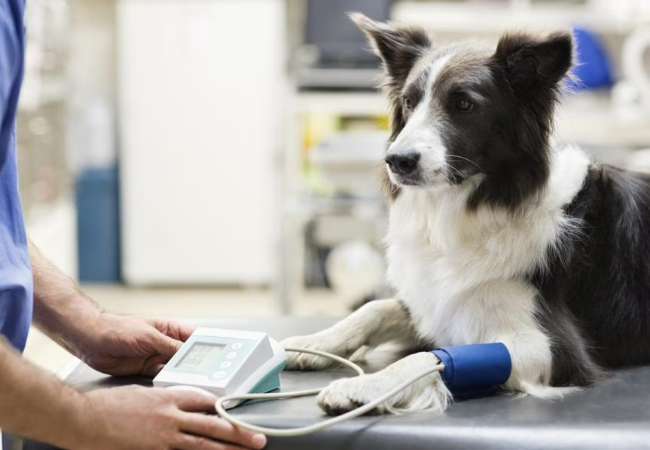Veterinary Guide to High Blood Pressure in Dogs 2025 ⚕️🐕

In this article
Veterinary Guide to High Blood Pressure in Dogs 2025 ⚕️🐕
By Dr. Duncan Houston BVSc
🩺 What is Canine Hypertension?
Systemic hypertension—high blood pressure in the body’s arterial system—is increasingly recognized in dogs, especially seniors or those with chronic disease. It poses silent threats to organs like the eyes, kidneys, brain, and heart.
Values above 160 mmHg systolic are considered high, with diastolic > 100 and MAP > 120–140 mmHg also abnormal.
👥 Who Is at Risk?
Hypertension in dogs is usually secondary to diseases like:
- Chronic kidney disease or failure
- Endocrine issues: Cushing’s, diabetes
- Heart disease: valvular, cardiomyopathy
- Neurologic disorders
Primary (idiopathic) hypertension is rare. Older dogs, especially over 9, benefit from annual BP screening per ACVIM guidelines.
🔍 Signs & Target-Organ Damage
High BP may be asymptomatic, but dangers include:
- Eyes: retinal hemorrhage or detachment → sudden blindness, dilated pupils.
- Kidneys: worsening disease and proteinuria.
- Brain: seizures, disorientation, circular walking.
- Heart & vessels: murmurs, CHF, hemorrhages.
- Nosebleeds: epistaxis from vessel rupture.
- Lethargy, weakness, rapid breathing.
📏 How is Blood Pressure Measured?
Veterinary BP techniques:
- Cuffs: placed on tail or limb, sized at ~40% circumference.
- Doppler + sphygmomanometer: detects flow and systolic read.
- Oscillometric digital devices: automated readings.
Multiple measurements are averaged. “White-coat syndrome” can cause false highs, so calm prep in quiet rooms helps.
📋 Diagnosis & Monitoring
- Repeat confirmed high readings.
- Search for underlying disease—bloodwork, urinalysis, T4, imaging.
- Evaluate target organ damage—eye exams, kidney tests, ECGs, imaging.
- Establish a monitoring plan as per the ACVIM consensus: follow readings and clinical signs.
💊 Treatment Approaches
Goals: reduce BP below 160 systolic and prevent damage.
Medications:
- ACE inhibitors: enalapril, benazepril. First-line, reduce vasoconstriction.
- Calcium channel blockers: amlodipine; effective but may impact kidneys.
- ARBs, beta-blockers, diuretics: adjuncts in resistant cases.
Medication choice depends on cause, comorbidities, tolerance, and cost.
Addressing the Underlying Disease
- Kidney disease: renal diets, phosphate control.
- Cushing’s/diabetes: endocrine therapy.
- Heart disease: appropriate cardiology protocols.
Monitoring
Recheck 2–4 weeks post-start, then every 3–6 months or sooner if unstable. Watch labs to prevent med side effects.
🏡 Home and Lifestyle Management
- Reduce stress—quiet spaces, routine, softer lighting.
- Encourage gentle exercise, weight management.
- Control sodium intake if directed by the vet.
- Safeguard vision—non-skid mats, night lights.
Tools like ToeGrips® may help stability in older dogs with neurologic signs.
📱 Ask A Vet Services & Integration
How Ask A Vet supports hypertensive dogs:
- Telehealth follow-up: remote BP tracking, medication reviews.
- Help accessing home BP monitoring devices and professional training for accurate readings.
📈 Prognosis
With early detection and management:
- Organ damage can stabilize, reducing blindness or renal decline risk.
- Quality of life can improve significantly.
- Without treatment, chronic hypertension shortens lifespan due to TOD.
✅ Owner's Action Checklist
- Ask your vet about BP screening if your dog is ≥9 years or has CKD, Cushing’s, or diabetes.
- Track any changes—vision, nosebleeds, disorientation.
- Ensure meds taken, follow-up BP checks done.
- Use the Ask A Vet app for scheduling, reminders, and diet planning.
- Create a calm, low-impact home environment with traction aids and cozy spaces.
🎓 Case Highlight: “Bella” the Border Collie
Bella, a 12-year-old Border Collie with CKD, was found with 180 mmHg systolic during routine wellness. With enalapril, renal diet, and remote Woopf tracking, BP stabilized to 145 mmHg. Follow-up imaging showed no further eye or kidney damage. Owner reports Bella’s energy back to her “old self”—long evening strolls resumed after six weeks.
🔚 Closing Thoughts
Canine hypertension is often overlooked, yet manageable with vigilance, veterinary care, and lifestyle adjustments. Use this 2025 guide to help your pet live a healthier, happier life. And remember, Ask A Vet is here for guidance every step of the way 🐾❤️.
Dr Duncan Houston BVSc, Ask A Vet founder. Don’t forget to download the Ask A Vet app for expert support anytime—your pup deserves paw-fect care! 🐶






